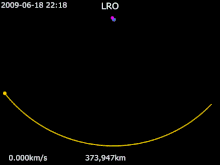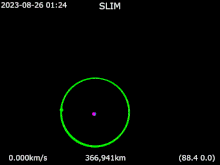Lunar orbit

In astronomy and spaceflight, a lunar orbit (also known as a selenocentric orbit) is an orbit by an object around Earth's Moon. In general these orbits are not circular. When farthest from the Moon (at apoapsis) a spacecraft is said to be at apolune, apocynthion, or aposelene. When closest to the Moon (at periapsis) it is said to be at perilune, pericynthion, or periselene. These derive from names or epithets of the moon goddess.
Lunar orbit insertion (LOI) is an orbit insertion maneuver used to achieve lunar orbit.[1]
Low lunar orbit (LLO) is an orbit below 100 km (62 mi) altitude. These have a period of about 2 hours.[2] They are of particular interest in the exploration of the Moon, but suffer from gravitational perturbations that make most unstable, and leave only a few orbital trajectories possible for indefinite frozen orbits. These would be useful for long-term stays in LLO.[2]
Perturbation effects and low orbits
[edit]Most lunar low orbits below 100 km (60 mi) are unstable.[2]

Gravitational anomalies slightly distorting the orbits of some Lunar Orbiters led to the discovery of mass concentrations (dubbed mascons) beneath the lunar surface caused by large impacting bodies at some remote time in the past.[2][3] These anomalies are large enough to cause a lunar orbit to change significantly over the course of several days. They can cause a plumb bob to hang about a third of a degree off vertical, pointing toward the mascon, and increase the force of gravity by one-half percent.[2] The Apollo 11 first manned landing mission employed the first attempt to correct for the perturbation effect (the frozen orbits were not known at that time). The parking orbit was "circularized" at 66 nautical miles (122 km; 76 mi) by 54 nautical miles (100 km; 62 mi), which was expected to become the nominal circular 60 nautical miles (110 km; 69 mi) when the LM made its return rendezvous with the CSM. But the effect was overestimated by a factor of two; at rendezvous, the orbit was calculated to be 63.2 nautical miles (117.0 km; 72.7 mi) by 56.8 nautical miles (105.2 km; 65.4 mi). [4]
Stable low orbits
[edit]Study of the mascons' effect on lunar spacecraft led to the discovery in 2001 of frozen orbits occurring at four orbital inclinations: 27°, 50°, 76°, and 86°, in which a spacecraft can stay in a low orbit indefinitely.[2] The Apollo 15 subsatellite PFS-1 and the Apollo 16 subsatellite PFS-2, both small satellites released from the Apollo Service Module, contributed to this discovery. PFS-1 ended up in a long-lasting orbit, at 28° inclination, and successfully completed its mission after one and a half years. PFS-2 was placed in a particularly unstable orbital inclination of 11°, and lasted only 35 days in orbit before crashing into the lunar surface.[2]
Lunar high orbits
[edit]For lunar orbits with altitudes in the 500 to 20,000 km (300 to 12,000 mi) range, the gravity of Earth leads to orbit perturbations. At altitudes higher than that perturbed two-body astrodynamics models are insufficient and three-body models are required.[5]
Although the Moon's Hill sphere extends to a radius of 60,000 km (37,000 mi),[6] the gravity of Earth intervenes enough to make lunar orbits unstable at a distance of 690 km (430 mi).[7]
The Lagrange points of the Earth-Moon system can provide stable orbits in the lunar vicinity, such as halo orbits and distant retrograde orbits.
Some halo orbits remain over particular regions of the lunar surface. These can be used by lunar relay satellites to communicate with surface stations on the far side of the Moon. The first to do this was the 2019 Queqiao relay satellite. It was placed around Earth-Moon L2 at roughly 65,000 km (40,000 mi).[citation needed]

Since 2022 (CAPSTONE) near-rectilinear halo orbits, using as well a Lagrange point, have been used and are planned to be employed by the Lunar Gateway.


Orbital transfer
[edit]There are three main ways to get to lunar orbit from Earth: direct transfer, low thrust transfer and low-energy transfer. These take 3–4 days, [word missing] months or 2.5–4 months respectively.[8]

Lunar Reconnaissance Orbiter · Earth · Moon


History of missions to lunar orbit
[edit]First orbiters
[edit]
The Soviet Union sent the first spacecraft to the vicinity of the Moon (or any extraterrestrial object), the robotic vehicle Luna 1, on January 4, 1959.[11] It passed within 6,000 kilometres (3,200 nmi; 3,700 mi) of the Moon's surface, but did not achieve lunar orbit.[11] Luna 3, launched on October 4, 1959, was the first robotic spacecraft to complete a circumlunar free return trajectory, still not a lunar orbit, but a figure-8 trajectory which swung around the far side of the Moon and returned to the Earth. This craft provided the first pictures of the far side of the Lunar surface.[11]
Luna 10 became the first spacecraft to actually orbit the Moon and any extraterrestrial body in April 1966.[12] It studied micrometeoroid flux, and lunar environment until May 30, 1966.[12] A follow-on mission, Luna 11, was launched on August 24, 1966, and studied lunar gravitational anomalies, radiation and solar wind measurements.
The first United States spacecraft to orbit the Moon was Lunar Orbiter 1 on August 14, 1966.[13] The first orbit was an elliptical orbit, with an apolune of 1,008 nautical miles (1,867 km; 1,160 mi) and a perilune of 102.1 nautical miles (189.1 km; 117.5 mi).[14] Then the orbit was circularized at around 170 nautical miles (310 km; 200 mi) to obtain suitable imagery. Five such spacecraft were launched over a period of thirteen months, all of which successfully mapped the Moon, primarily for the purpose of finding suitable Apollo program landing sites.[13]
Crewed and later orbiters
[edit]The Apollo program's Command/Service Module (CSM) remained in a lunar parking orbit while the Lunar Module (LM) landed. The combined CSM/LM would first enter an elliptical orbit, nominally 170 nautical miles (310 km; 200 mi) by 60 nautical miles (110 km; 69 mi), which was then changed to a circular parking orbit of about 60 nautical miles (110 km; 69 mi). Orbital periods vary according to the sum of apoapsis and periapsis, and for the CSM were about two hours. The LM began its landing sequence with a Descent Orbit Insertion (DOI) burn to lower their periapsis to about 50,000 feet (15 km; 8.2 nmi), chosen to avoid hitting lunar mountains reaching heights of 20,000 feet (6.1 km; 3.3 nmi). After the second landing mission, the procedure was changed on Apollo 14 to save more of the LM fuel for its powered descent, by using the CSM's fuel to perform the DOI burn, and later raising its periapsis back to a circular orbit after the LM had made its landing.[15]
See also
[edit]- Cislunar space
- List of orbits
- Orbital mechanics
- Distant retrograde orbit
- Near-rectilinear halo orbit
References
[edit]- ^ Woods, W.D. (2008). "Entering lunar orbit: the LOI manoeuvre". How Apollo Flew to the Moon. Space Exploration. Springer Praxis Books. pp. 189–210. doi:10.1007/978-0-387-74066-9_8. ISBN 978-0-387-71675-6.
- ^ a b c d e f g
"Bizarre Lunar Orbits". NASA Science: Science News. NASA. 2006-11-06. Retrieved 2012-12-09.
Lunar mascons make most low lunar orbits unstable ... As a satellite passes 50 or 60 miles overhead, the mascons pull it forward, back, left, right, or down, the exact direction and magnitude of the tugging depends on the satellite's trajectory. Absent any periodic boosts from onboard rockets to correct the orbit, most satellites released into low lunar orbits (under about 60 miles or 100 km) will eventually crash into the Moon. ... [There are] a number of 'frozen orbits' where a spacecraft can stay in a low lunar orbit indefinitely. They occur at four inclinations: 27°, 50°, 76°, and 86° — the last one being nearly over the lunar poles. The orbit of the relatively long-lived Apollo 15 subsatellite PFS-1 had an inclination of 28°, which turned out to be close to the inclination of one of the frozen orbits—but poor PFS-2 was cursed with an inclination of only 11°.
- ^ Konopliv, A. S.; Asmar, S. W.; Carranza, E.; Sjogren, W. L.; Yuan, D. N. (2001-03-01). "Recent Gravity Models as a Result of the Lunar Prospector Mission". Icarus. 150 (1): 1–18. Bibcode:2001Icar..150....1K. doi:10.1006/icar.2000.6573. ISSN 0019-1035.
- ^ "Apollo 11 Mission Report" (PDF). NASA. pp. 4–3 to 4–4.
- ^ Ely, Todd (July 2005). "Stable Constellations of Frozen Elliptical Inclined Lunar Orbits". The Journal of the Astronautical Sciences. 53 (3): 301–316. Bibcode:2005JAnSc..53..301E. doi:10.1007/BF03546355.
- ^ Follows, Mike (4 October 2017). "Ever Decreasing Circles". NewScientist.com. Retrieved 23 July 2023.
The moon's Hill sphere has a radius of 60,000 kilometres, about one-sixth of the distance between it and Earth.
For mean distance and mass data for the bodies (for verification of the foregoing citation), see Williams, David R. (20 December 2021). "Moon Fact Sheet". NASA.gov. Greenbelt, MD: NASA Goddard Space Flight Center. Retrieved 23 July 2023. - ^ "A New Paradigm for Lunar Orbits". Phys.org. 2006-12-01. Retrieved 2023-11-05.
- ^ The Aerospace Corporation (2023-07-20). "It's International Moon Day! Let's talk about Cislunar Space". Medium. Retrieved 2023-11-07.
- ^ Stein, Ben P. (August 23, 2011). "45 Years Ago: How the 1st Photo of Earth From the Moon Happened". Space.com. Retrieved October 7, 2020.
- ^ "Fifty Years Ago, This Photo Captured the First View of Earth From the Moon". August 23, 2016. Archived from the original on August 25, 2016.
- ^ a b c Wade, Mark. "Luna". Encyclopedia Astronautica. Archived from the original on 2012-01-11. Retrieved 2007-02-17.
- ^ a b Byers, Bruce K. (1976-12-14). "APPENDIX C [367-373] RECORD OF UNMANNED LUNAR PROBES, 1958-1968: Soviet Union". DESTINATION MOON: A History of the Lunar Orbiter Program. National Aeronautics and Space Administration. Archived from the original on 2021-01-26. Retrieved 2007-02-17.
- ^ a b Wade, Mark. "Lunar Orbiter". Encyclopedia Astronautica. Archived from the original on August 21, 2002. Retrieved 2007-02-17.
- ^ Byers, Bruce K. (1976-12-14). "CHAPTER IX: MISSIONS I, II, III: APOLLO SITE SEARCH AND VERIFICATION, The First Launch". DESTINATION MOON: A History of the Lunar Orbiter Program. National Aeronautics and Space Administration. Archived from the original on 2020-09-27. Retrieved 2007-02-17.
- ^ Jones, Eric M. (1976-12-14). "The First Lunar Landing". Apollo 11 Lunar Surface Journal. National Aeronautics and Space Administration. Retrieved 2014-11-09.
